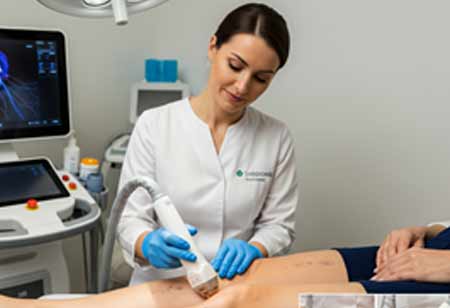Thank you for Subscribing to Healthcare Business Review Weekly Brief
Be first to read the latest tech news, Industry Leader's Insights, and CIO interviews of medium and large enterprises exclusively from Healthcare Business Review
Advancing Vascular Wellness with Vein Treatment Services
Vein treatment services are advancing with AI, improving diagnostics and outcomes, while addressing cosmetic and health concerns for patients.

By
Healthcare Business Review | Monday, October 27, 2025
Stay ahead of the industry with exclusive feature stories on the top companies, expert insights and the latest news delivered straight to your inbox. Subscribe today.
The global demand for vein treatment services is driven by an aging population, increasing awareness of cosmetic and health concerns associated with venous disorders, and technological advancements in minimally invasive procedures. The market for vein treatment services is evolving rapidly, incorporating AI, advanced imaging tools, and novel therapeutic approaches to enhance diagnostic accuracy, improve patient outcomes, and increase operational efficiency. Age-related weakening of vein walls and valves increases the risk of varicose veins and related disorders. Coupled with sedentary lifestyles, obesity, and prolonged periods of standing or sitting, which are common in modern occupations, these conditions have become increasingly prevalent.
AI is being integrated across several phases of vein treatment. AI-powered diagnostic tools enable clinicians to accurately identify vein abnormalities using advanced imaging techniques, including duplex ultrasound and MRI venography. AI algorithms analyze vein structure, blood flow, and valve functionality, reducing the likelihood of human error and expediting treatment planning. ML models help predict treatment outcomes, recurrence probabilities, and patient-specific risk factors, enabling personalized treatment strategies. Laser therapy, radiofrequency ablation, and sclerotherapy are among the most popular treatment modalities in the modern vein clinic.
Market Catalysts and Technology Integration
The methods are increasingly refined with robotics and AI-guided delivery systems that optimize precision and minimize tissue damage. Telemedicine and digital platforms have become integral to the service model, enabling remote consultations, post-treatment monitoring, and increased accessibility for patients in underserved areas. Patients now demand quick and efficient solutions that accommodate their busy lifestyles, and outpatient clinics effectively cater to this expectation. Variability in clinical approaches and outcome measurement makes comparing success rates and establishing best practices difficult.
Developing industry-wide treatment guidelines supported by AI-generated data analytics can ensure consistency and quality across providers. Collaboration among clinics, academic institutions, and regulatory bodies is essential for standardization and continuous improvement. Patient reluctance due to misconceptions, fear of procedures, or cosmetic stigma still exists. Public education campaigns, transparent communication, and sharing success stories can help dispel myths and encourage timely medical intervention.
Clinical Applications and Demand Dynamics
Vein treatment services address a wide range of clinical applications beyond aesthetics. Treatments improve appearance, mobility, comfort, and overall quality of life. Left untreated, venous disorders can lead to swelling, pain, skin changes, and, in severe cases, life-threatening complications like blood clots or pulmonary embolism. AI and image-guided procedures allow clinicians to deliver more accurate, patient-specific treatments. With AI integration, vein mapping and catheter navigation are enhanced, resulting in reduced procedure time and improved efficacy. Foam sclerotherapy, used for smaller varicose and spider veins, also benefits from real-time AI image analysis, ensuring optimal distribution of the sclerosant agent.
Vein treatment services have a significant impact on healthcare systems by reducing long-term disease burdens and associated costs. Early interventions prevent the progression of venous disorders and reduce the need for hospitalization or surgical procedures. Employers also benefit, as treated patients experience fewer work absences and improved productivity. From a public health perspective, enhancing access to vein care contributes to community wellness, particularly in aging societies where mobility and cardiovascular health are paramount.
The demand for vein treatment services is growing in developed regions and emerging markets, where rising incomes, medical tourism, and improved healthcare infrastructure contribute to increased adoption. Various countries are witnessing a surge in vein clinic openings and patient inflow thanks to affordable yet high-quality treatment options. Expanding insurance coverage for specific vein treatments makes services more accessible across socioeconomic strata. Wearable health technology is gaining popularity, with devices capable of monitoring vascular health parameters, such as blood pressure, circulation efficiency, and recovery status, thereby empowering patients and physicians.
Strategic Solutions and Future Outlook
Without skilled practitioners, access to quality care remains limited. The costs associated with advanced imaging equipment and AI-enabled tools can be prohibitive for small clinics, creating disparities in care delivery. Medical institutions and technology providers must invest in training programs, telehealth platforms, and resource-sharing networks. AI-based remote diagnostics can empower general practitioners and nurses to screen for vein conditions, referring complex cases to specialists. Mobile vein clinics and community outreach initiatives can extend care to remote populations.
Integrating AI-driven chatbots and educational tools into clinic websites or patient portals can enhance awareness and engagement. Reimbursement policies also pose barriers to adoption. In many healthcare systems, insurance coverage for vein treatment is limited or inconsistent, often categorized as cosmetic rather than medically necessary. Advocacy for policy reform and demonstrating long-term health benefits through clinical studies can help expand coverage and reduce out-of-pocket patient expenses. The deeper integration of AI, personalized medicine, and real-time monitoring will shape the future of vein treatment services.
Smart wearables will not only track post-treatment progress but may also detect early signs of venous disease. AI models will become increasingly predictive, enabling clinicians to intervene proactively. VR and AR may play a role in training and real-time procedure guidance, enhancing precision and practitioner confidence. The vein treatment service market is undergoing a profound transformation, driven by demographic shifts, technological advancements, and evolving patient expectations. The industry can deliver highly effective, patient-centered solutions by leveraging AI, improving access, addressing training and policy challenges, and standardizing care.






